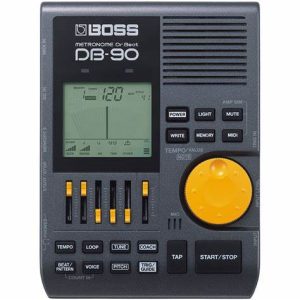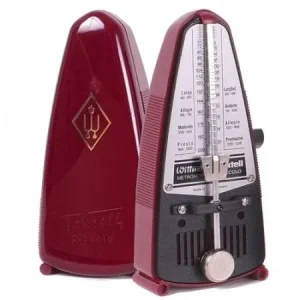Best Metronomes for Guitar Practice (2024 Reviews)

The BOSS DB-90 Dr. Beat

-
Tempo Range:30-250 BPM, suitable for various musical styles.
-
Rhythm Patterns:Includes multiple patterns and time signatures.
-
Human Voice Count:Offers vocal counting for beats.
-
PCM Drum Sounds:Provides realistic drum sounds for practice.
-
Rhythm Coach Function:Assists in improving timing and precision.
The BOSS DB-90 Dr. Beat is a versatile metronome renowned for its comprehensive features, making it a favorite among musicians. It offers a wide tempo range and multiple rhythm patterns, accommodating diverse practice requirements.
The inclusion of a human voice count and PCM drum sounds enhances the practice experience, providing a more musical feel. Additionally, its Rhythm Coach function aids in developing timing and accuracy.
-
Extensive range of features.
-
High-quality sound options.
-
User-friendly interface.
-
Higher price point compared to basic metronomes.
-
May be complex for beginners due to its numerous features.
The Korg KDM-3 Digital Metronome

-
Tempo Range:30-252 BPM with 19 beat patterns.
-
Sound Options:Eight metronome sounds, including a mechanical metronome sound.
-
Design:Classic look with a compact, portable build.
-
High-Output Speaker:Ensures clear sound in various settings.
-
Timer Mode:Allows setting practice session durations.
Pros:
Combines traditional design with digital accuracy.
Multiple sound options to suit user preferences.
Portable and easy to use.
Cons:
Limited advanced features compared to higher-end models.
No built-in tuner functionality.
BOSS TU-30 Tuner and Metronome

-
Dual Functionality: Combines tuner and metronome in one unit.
-
Tuning Modes: Supports chromatic, guitar, and bass tuning.
-
Metronome: Offers multiple rhythm styles and visual display.
-
Accu-Pitch Function:Sounds a tone when the correct pitch is reached.
-
Portability: Compact design suitable for travel.
The BOSS TU-30 combines a tuner and metronome in a compact unit, offering convenience for musicians. It supports chromatic tuning, as well as specific modes for guitar and bass, ensuring accurate tuning across various instruments.
The metronome features multiple rhythm styles and a visual display, aiding in effective practice sessions. Its small size makes it easy to carry, fitting into most instrument cases.
-
Pros:
-
Combines two essential tools in one device.
-
User-friendly interface with clear display.
-
Portable and lightweight.
Cons:-
Limited advanced features compared to dedicated devices.
-
Plastic construction may not be as durable as metal alternatives.
.
-
Wittner 836 Taktell Piccolo Metronome

-
Mechanical Operation:No batteries required; wind-up mechanism.
-
Tempo Range:40-208 BPM with adjustable tempo settings.
-
Audible Click:Clear sound for effective practice.
-
Compact Design:Easy to transport and store.
-
Durable Build:High-quality materials ensure longevity.
-
Reliable and consistent tempo.
-
No need for power sources.
-
Aesthetic appeal with a classic design.
-
Lacks advanced features found in digital metronomes.
-
Volume may not be sufficient in noisy environments.
Soundbrenner Pulse Wearable Metronome

-
Wearable Design:Provides tactile timing cues.
-
Bluetooth Connectivity:Syncs with a smartphone app for customization.
-
Multi-User Sync:Allows synchronization with multiple devices.
-
Silent Operation:Ideal for noise-sensitive environments.
-
Rechargeable Battery:Offers long usage time per charge.
The Soundbrenner Pulse is a unique wearable metronome that delivers vibrations to help musicians stay in time. It connects via Bluetooth to a smartphone app, allowing for customizable rhythms and tempos.
The device can be worn on the wrist, arm, or leg, providing a tactile sense of timing without the intrusive sound of a traditional metronome. It's particularly useful in live performance settings where audible clicks are undesirable.
-
Innovative approach to timing.
-
Customizable and versatile.
-
Discreet and silent operation.
-
Requires a smartphone for full functionality.
-
Learning curve for those accustomed to audible metronomes.

